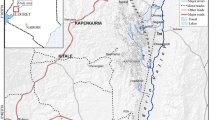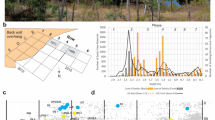Abstract
A typology of artificial rock hollows and tentative identification of their functions is founded upon study of recent practices at Sukur. Five stages of development of equipment for grinding grain are identified and shown, using field archaeological evidence, to constitute a sequence of historical phases that extends from the Neolithic or early Iron Age to the present. The development of other types of hollows is related to this sequence. Ethnographic data are employed to estimate the use lives of grain grinding hollows, which are interpreted in terms of woman-centered familial grain-grinding units. The evidence suggests that prior to ca. AD 1600 the population density averaged two orders of magnitude less than in recent times—with important implications for regional culture history. This exploratory study demonstrates the potential of artificial hollows as evidence for the study of prehistory, culture and demographic history, and the history of landscape in Africa and beyond.
Similar content being viewed by others
REFERENCES CITED
Adams, J. L. (1993). Toward understanding the technological development of manos and metates. Kiva 58(3): 331–344.
Adams, J. L. (1996). Manual for a Technological Approach to Ground Stone Analysis, Center for Desert Archaeology, Tucson.
Adams, J. L. (1997). Manos and metates as subsistence indicators. Paper presented at the 62nd Annual Meeting of the Society for American Archaeology, Nashville, TN, April.
Aschmann, H. (1949). A metate maker of Baja California. American Anthropologist 51: 682–686.
Barreteau, D., and Jungraithmayr, H. (1993). Calculs lexicostatistiques et glottochronologiques sur les langues tchadiques. In Barreteau, D., and von Graffenried, C. (eds.), Datation et chronologie dans le bassin du Lac Tchad (Actes du Séminaire du Réseau Méga-Tchad, ORSTOM-Bondy, 11–12 septembre 1989), Éditions ORSTOM, Paris, pp. 103–40.
Bernus, S., and Cressier, P. (1991). La région d'In Gall-Tegidda n Tesemt (Niger). Programme archéologique d'urgence 1977–81. IV. Azelick-Takadda et l'implantation sédentaire médiévale, Études Nigériennes 51, Institut de Recherches en Sciences Humaines, Niamey.
David, N. (1996). A new political form? The classiess industrial society of Sukur (Nigeria). In Pwiti, G., and Soper, R. (eds.), Proceedings of the 10th Pan-African Congress on Prehistory and Related Studies (Harare, June 1995), University of Zimbabwe Press, Harare, pp. 593–600.
David, N., and Sterner, J. (1995). Constructing a historical ethnography of Sukur (Adamawa State), I. Demystification. Nigerian Heritage 4: 11–33.
David, N., and Sterner, J. (1996). Constructing a historical ethnography of Sukur (Adamawa State). II. Iron and the classless industrial society. Nigerian Heritage 5: 11–33.
Davies, O. (1967). West Africa Before the Europeans. Archaeology and Prehistory, Methuen, London.
Derricourt, R. (1986). Striated grinding grooves in Central Africa. South African Archaeological Bulletin 41(143): 27–31.
Fagg, W. (1959). Grooved rocks at Apoje near Ijebu-Igbo, Western Nigeria. Man 59(330): 204–205.
Fosbrooke, H. A. (1954). Further light on rock engravings in northern Tanganyika. Man 54(157): 100–102.
Foxhall, L., and Forbes, H. (1982). The role of grain as a staple in Classical Antiquity. Chiron 12: 41–90.
Gardi, R. (1996). Momente des Alltags. Fotodokumente aus Nord-Kamerun 1950–1986 (Tschadsee, Mandara, Alantika), Museum für Völkerkunde Basel, Basel.
Gosselain, O. (1995). Identités techniques. Le travail de la poterie Cameroun méridional. Description des chaînes opératoires (2 vols), Thèse de Doctorat en Philosophie et Lettres, Université Libre de Bruxelles.
Hallaire, A. (1991). Paysans montagnards du Nord-Cameroun: les monts Mandara, Éditions de l'ORSTOM, Paris.
Hard, R. J., Mauldin, R. P., and Raymond, G. L. (1996). Mano size, stable carbon isotope retios, and macrobotanical remains as multiple lines of evidence of maize dependence in the American Southwest. Journal of Archaeological Method and Theory 3(4): 253–318.
Hayden, B. (1987a). Traditional metate manufacturing in Guatemala using chipped stone tools. In Hayden, B. (ed.), Lithic Studies Among the Contemporary Highland Maya, University of Arizona, Tucson, pp. 8–119.
Hayden, B. (1987b). Past to present use of stone tools and their effects on assemblage characteristics in the Maya highlands. In Hayden, B. (ed.), Lithic Studies Among the Contemporary Highland Maya, University of Arizona, Tucson, pp. 160–234.
Horsfall, G. A. (1987). A design theory perspective on variability in grinding stones. In Hayden, B. (ed.), Lithic Studies Among the Contemporary Highland Maya, University of Arizona, Tucson, pp. 332–378.
Jackson, T. L. (1991). Pounding acorn: women's production as social and economic focus. In Gero, J., and Conkey, M. W. (eds.), Engendering Archaeology: Women and Prehistory, Basil Blackwell, Oxford, pp. 301–325.
Kennedy, R. A. (1962). “Grinding benches” and mortars on Fernando Po. Man 62(213): 1228–1230.
Kirk-Greene, A. H. M. (1960). The kingdom of Sukur—A Northern Nigerian Ichabod. Nigerian Field 25(2): 67–96.
MacEachern, A. S. (1993). Selling the iron for their shackles: Wandala-montagnard interactions in northern Cameroon. Journal of African History 33(2): 241–270.
MacEachern, A. S. (1996). Iron Age beginnings north of the Mandara Mountains, Cameroon and Nigeria. In Pwiti, G., and Soper, R. (eds.), Proceedings of the 10th Pan-African Congress on Prehistory and Related Studies (Harare, June 1995), University of Zimbabwe Press, Harare, pp. 489–496.
Meek, C. K. (1931). Tribal Studies in Northern Nigeria, Vols. I and II, Kegan Paul, Trench, Trubner, London.
Mouchet, J.-J. (1947–1948). Prospection ethnologique sommaire de quelques massifs du Mandara. V. Massif Mada. Études camerounaises 21–22: 105–119.
Pontié, G. (1984). Les sociétés païennes. In Boutrais, J. (ed.), Le nord du Cameroun, des hommes, une région, Collection Mémoires, 102, ORSTOM, Paris, pp. 203–232.
Roux, V. (1985). Le matériel de broyage: étude ethnoarchéologique à Tichitt, Mauritanie, Mémoire 58, Éditions Recherches sur les Civilisations, Paris.
Sassoon, H. (1962). Grinding grooves and pits in northern Nigeria. Man 62(232): 144–145.
Shaw, C. T. (1944). Excavations at “Bosumpra” cave, Abetifi, Kwahu, Gold Coast Colony. Proceedings of the Prehistoric Society 20: 1–67.
Shepard, A. O. (1965). Ceramics for the Archaeologist, Carnegie Institution of Washington, Washington, DC.
Smith, A., and David, N. (1995). The production of space and the house of Xidi Sukur. Current Anthropology 36(3): 441–471.
Sterner, J. A. (1992). Sacred pots and “symbolic reservoirs” in the Mandara highlands of northern Cameroon. In Sterner, J.A., and David, N. (eds.), An African Commitment: Papers in Honour of P. L. Shinnie, University of Calgary Press, Calgary, pp. 171–180.
Wright, K. I. (1992). A classification system for ground stone tools from the prehistoric Levant. Paléorient 18(2): 53–81.
Wright, K. I. (1994). Ground-stone tools and hunter-gatherer subsistence in southwest Asia: Implications for the transition to farming. American Antiquity 59(2): 238–263.
Author information
Authors and Affiliations
Rights and permissions
About this article
Cite this article
David, N. The Ethnoarchaeology and Field Archaeology of Grinding at Sukur, Adamawa State, Nigeria. African Archaeological Review 15, 13–63 (1998). https://doi.org/10.1023/A:1022270208256
Issue Date:
DOI: https://doi.org/10.1023/A:1022270208256




